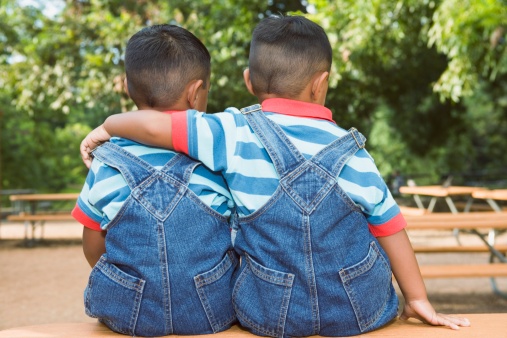 How do children learn about other people and themselves?
How do children learn about other people and themselves?
A baby shakes a rattle and her mother shakes another rattle in return. Delighted, the baby repeats the game, this time to peals of laughter. The baby is tickled by the fact that someone is reciprocating. Imitation is flattering, even to infants.
Our research at I-LABS shows imitation is also serious business. Young children use it to learn how the world works. It teaches them about causal relations – how actions make things happen. Through imitation, they learn how to use levers, telephones, forks, chopsticks and other tools of the culture.
But children and adults are also interested in something deeper. They want to understand what is going on inside other people. In everyday interactions, they try to grasp other people’s desires, thoughts and emotions. Scientists refer to this as the puzzle of “other minds.”
What makes it a puzzle is that we can’t actually see the internal states of others. Yet when we observe upturned corners of a mouth, we immediately sense happiness. When we see streaks of tears, we register a person’s sadness. How does the brain make the leap from these behaviors to the feelings that underlie them? What are the mechanisms for social-emotional understanding? And when does a child’s learning enable this all-important step?
Understanding emotions is key to social-emotional health, empathy, reflective parenting, and what some call “mindfulness.”
Empathy is built on the ability to put ourselves in another person’s shoes. Young children have difficulty taking the perspective of others. During the “terrible twos” children don’t understand that others could want something different from what they want. By about 5 years of age, children have learned that two people can look at the same thing and feel or think differently about it. It is an insight that reorganizes their emotional lives.
Scientists at I-LABS are exploring perspective-taking and what makes some individuals more empathetic than others. Children with autism have particular difficulty understanding ‘other minds’ and cannot easily take the perspective of others. Research at I-LABS is driving new programs by clinicians to help children with autism learn these skills.
The typical child’s tendency to relate to others socially is pervasive and positive, but it also opens them up to absorbing stereotypes from the parents, peers, teachers, media, and wider culture around them. One dramatic effect is that the social expectations of others influence children’s academic interests, choices and aspirations.
For example, only about 25 percent of the undergraduate degrees in computer sciences in the U.S. are granted to women. New research at I-LABS suggests that this may not be fixed by biology but could be the result of young girls assimilating our culture’s gender stereotypes about women’s interest and ability to succeed in science, technology, engineering, and mathematical (STEM) fields.
This leads to hard questions: When do children first become aware of stereotypes (gender, racial, and others)? How do we go about reversing the impact of these stereotypes? The long-term goal of I-LABS’ research is to intervene with children, teachers and parents. Working together with our colleagues and partners, we intend to design learning environments that can change or overcome the pernicious effects of negative stereotypes and foster a positive sense of identity in young minds.
Our children are like sponges. They not only learn skills from watching us, but also from our sense of caring for others, and from our biases and prejudices. We want to project positive images that reflect our values right from the beginning.
